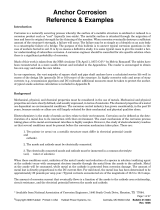Page is loading ...

Instruments and Equipment for the Corrosion Engineer
11640 U.S. Highway 1, Sebastian, FL 32958
Tel: 772-794-9448 ~ Fax: 772-589-9072
Copyright 2012 M. C. Miller Co., Inc.
All Rights Reserved
MAN230
Soil Box Instructions
Purpose:
Measurement of electrical resistivity (in ohm-centimeter) of liquid or earth, sand or other
particulate material that can be tamped into the soil box.
Equipment Required:
1.) M.C. Miller Soil Box (Large Box, Catalog # 37008 or Small Box, Catalog # 37006)
2.) 4-Terminal Resistance Meter (e.g. Miller 400A or Miller 400D) or any
ammeter/voltmeter combination together with a power supply
3.) Four Insulated MCM Soil Box Test Leads (Catalog # 37009)
Procedure:
1) Pour or tamp material to be tested into soil box until level with top of box.
a) If soil is the material being tested, remove the two brass potential pins. After
removing the pins proceed to fill the soil box with the soil. When filling the box,
compaction is very crucial to obtaining accurate results. Make sure that the
compaction in the box resembles that of the compaction where the sample was
taken (see ASTM G-57 for correct procedure). Replace the brass pins.
b) If liquid is the material being tested, pour the liquid sample into the box until the
box is filled. To ensure that the box is completely filled make sure the bottom of
the meniscus formed from the liquid is completely level with the top of the box. If
the box is not consistently filled to the same level some inaccuracies will occur.
2) Connect the four test lead accessories for the MCM Soil Box as indicated in the
diagram shown below. (The leads are labeled C1, C2, P1, and P2).

Instruments and Equipment for the Corrosion Engineer
11640 U.S. Highway 1, Sebastian, FL 32958
Tel: 772-794-9448 ~ Fax: 772-589-9072
Copyright 2012 M. C. Miller Co., Inc.
All Rights Reserved
3) The two outer endpins of the soil box should be connected to the resistance meter
via the C1 and C2 terminals. (See diagram above)
4) The two inner pins of the soil box should be connected to the resistance meter via the
P1 and P2 terminals.
5) When all of the connections are made, the resistance value can be read from the
meter in ohms (see the section below entitled, “Resistance-to-Resistivity
Conversion”) in order to convert the resistance reading to a resistivity value.
Remarks:
The resistivity of both liquids and soils is a function of temperature. In order to obtain results
which best agree with field conditions, the sample should be at the same temperature as would
be experienced at the test site. The resistivity of soils is also a function of moisture content;
therefore, all soil samples should be kept tightly capped and measured as soon as possible after
they are removed from their containers. For further specifications, refer to the ASTM G57
procedure.
Soil boxes should be thoroughly cleaned with distilled water after each use.
The soil box may also be used with voltmeter/ammeter combinations together with a power
supply.

Instruments and Equipment for the Corrosion Engineer
11640 U.S. Highway 1, Sebastian, FL 32958
Tel: 772-794-9448 ~ Fax: 772-589-9072
Copyright 2012 M. C. Miller Co., Inc.
All Rights Reserved
Resistance-to-Resistivity Conversion:
SOIL BOX CRITICAL DIMENSIONS
The soil boxes are designed such that the cross-sectional area of the sample (A), with the box
filled level, divided by the separation between the pins (L) is equal to 1cm.
Small Soil Box (Cat. # 37006):
Cross-sectional area = 3cm x 2.4cm = 7.2cm²
Pin separation = 7.2cm
A/L = 1cm
Large Soil Box (Cat. # 37008):
Cross-sectional area = 4cm x 3.2cm = 12.8cm²
Pin separation = 12.8cm
A/L = 1cm
SAMPLE RESISTIVITY DETERMINATION
Assuming that a change in current passing through the sample (∆I) causes a change in voltage
dropped across the pins of ∆V, the resistance of the sample would be ∆V/∆I and the units would
be Ω, assuming that the current is in Amps and the voltage is in Volts (or that the current is in
milliamps and the voltage is in milli-volts).
Since, Resistivity = Resistance x (A/L), and since A/L is 1cm for the M. C. Miller soil boxes,
Sample Resistivity (Ω.cm) = Measured Resistance (Ω) x 1cm
/

